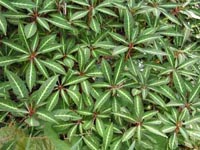Resource Library
Plant of the Week: Impatiens
The University of Arkansas System Division of Agriculture does not promote, support or recommend plants featured in "Plant of the Week." Please consult your local Extension office for plants suitable for your region.
Plant of the Week
Impatiens
Latin: impatiens omeiana

Gardeners occupy a small corner of the world stage. It’s a small space where we toil at our art, oftentimes hunkering down as a means of escape from the familial, local, national and international events that whirl around us like moons orbiting a distant planet.
But, there’s no escape, for everything is interconnected. The hardy impatiens that grow along my garden path are an example of these invisible strands.
Impatiens omeiana, the hardy impatiens, is a new plant to the garden world, having been introduced from China only in 1983. It grows about 16 inches tall with unbranched stems arising from slender, wide-spreading rhizomes. Colonies reach 2 feet across in two to three years. It has the watery stems of all balsams and dies to the ground with the first frost.
The most ornamental characteristic of the hardy impatiens is its narrow, 3-inch long leaves which have a broad band of creamy white down the midrib and secondary veins of each leaf. The petioles and stem are red, creating a subtle contrast. The overall effect is similar to that of the variegated New Guinea impatiens.
There’s little to recommend the flowers that appear at the end of each stem in early fall. They’re 1 1/2 inches long, yellow, shaped like our native jewel weed (Impatiens capensis), but sparingly produced.
This little plant grows in my garden because Mao Zedong died. Mao is credited with resurrecting China as an independent nation, free from foreign control for the first time since the Chinese lost the Opium Wars in the middle of the 19th century.
Undeniably, his reign was hard on the nation and her people. The suffering endured during the Cultural Revolution is mind numbing; the headlong rush we see in China today to modernize is a direct legacy of his long, repressive reign.
After Mao’s death in 1976, he was replaced by another member of the old guard, Deng Xiaoping (1904-1997). Deng began opening up the country to Western investment and travel in 1979.
From a gardening perspective, one of the first visitors to reenter China after the bamboo curtain opened was Dr. Don Jacobs, a Georgia ecologist who operated an experimental nursery called Eco-Gardens near Athens. Its mission was to study, display and sell native and exotic plants suited to the Piedmont region of the southeastern states.
Jacobs, born in 1919, was a northern boy who taught ecology at the University of Georgia. His interests ranging from reptiles to aquariums and eventually lead to a 20-year stint as owner of a pet store. After selling his pet store in the 1970s, he created Eco-Gardens and concentrated on plants. His credentials in ecology gave him early access to China under Deng.
Jacobs made three trips to the East, with his most successful collections coming during 1983 from Mount Emei, a 9,600-foot mountain in southeastern Sichuan Province. This mountain, long a popular spot for plant explorers, is also a place of pilgrimage for Chinese Buddhists. Over 70 temples adorn the mountain. The impatiens was found at about 8,000 feet in a cloud-shrouded forest of firs and tree rhododendrons.
Impatiens omeiana is hardy throughout Arkansas. It needs a location with shade or part sun, good summertime moisture, but otherwise is not fussy about its requirements. While most local nurseries will not offer the plant, it’s readily available from Internet sources.
By: Gerald Klingaman, retired
Extension Horticulturist - Ornamentals
Extension News - October 21, 2005
The University of Arkansas System Division of Agriculture does not maintain lists of retail outlets where these plants can be purchased. Please check your local nursery or other retail outlets to ask about the availability of these plants for your growing area.